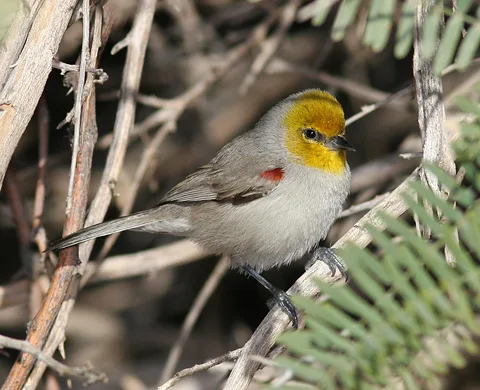
Verdin
[order] PASSERIFORMES | [family] Remizidae | [latin] Auriparus flaviceps | [UK] Verdin | [FR] Verdin doree | [DE] Goldkopfchen | [ES] Pajaro-moscon Baloncito | [NL] Geelkopmees
Subspecies
| Genus | Species | subspecies | Breeding Range | Breeding Range 2 | Non Breeding Range |
| Cephalopyrus | flaviceps | ||||
| Auriparus | flaviceps | NA, MA | sw USA, nw Mexico | ||
| Auriparus | flaviceps | acaciarum | |||
| Auriparus | flaviceps | flaviceps | |||
| Auriparus | flaviceps | hidalgensis | |||
| Auriparus | flaviceps | lamprocephalus | |||
| Auriparus | flaviceps | ornatus | |||
| Auriparus | flaviceps | sinaloae |
Physical charateristics
The Verdin is a species of penduline tit, and is one of the smallest perching birds in North America. It is mainly gray with yellow head and a reddish patch on the shoulders. The underside is paler gray. The tail is short and rounded. It has a sharp pointed bill. Male birds are brighter in color. Juvenile birds do not have yellow head or reddish shoulder patches.
Listen to the sound of Verdin
[audio:http://www.aviflevoland.nl/sounddb/V/Verdin.mp3]
Copyright remark: Most sounds derived from xeno-canto
| wingspan min.: | 16 | cm | wingspan max.: | 17 | cm |
| size min.: | 9 | cm | size max.: | 11 | cm |
| incubation min.: | 14 | days | incubation max.: | 18 | days |
| fledging min.: | 17 | days | fledging max.: | 21 | days |
| broods: | 1 | eggs min.: | 3 | ||
| eggs max.: | 6 |
Range
North America, Middle America : Southwest USA, Northwest Mexico
Habitat
Brushy desert valleys, mesquites.
Most common in Sonoran desert and mesquite woods at lower elevations. Also lives in other kinds of low open brush, including desert stands of acacia and paloverde, thickets of saltcedar, low riverside woods. Common in suburbs of some southwestern towns.
Most common in Sonoran desert and mesquite woods at lower elevations. Also lives in other kinds of low open brush, including desert stands of acacia and paloverde, thickets of saltcedar, low riverside woods. Common in suburbs of some southwestern towns.
Reproduction
Male may build several nests, with female choosing one to use for raising the young.
Nest: Placed well out on branches of thorny shrub or low tree, or in cholla cactus, usually 4-
12′ above the ground. Nest is a conspicuous hollow oval or sphere, surprisingly large for the size of the bird, made of thorny twigs. Entrance is low on one side; int
erior is well lined with feathers, grass, leaves, spider webs, for good insulation. Nests built late in spring tend to have entrance facing toward prevailing wind, which may help cool the interior.
Eggs: 4-5, sometimes 3-6. Pale green to blue-green, with reddish brown dots often concentrated around larger end. Incubation is by female, reportedly about 10 days.
Young: Both parents feed the nestlings. Young leave the nest about 21 days after hatching, but continue to return to nest to sleep at night.
Nest: Placed well out on branches of thorny shrub or low tree, or in cholla cactus, usually 4-
12′ above the ground. Nest is a conspicuous hollow oval or sphere, surprisingly large for the size of the bird, made of thorny twigs. Entrance is low on one side; int
erior is well lined with feathers, grass, leaves, spider webs, for good insulation. Nests built late in spring tend to have entrance facing toward prevailing wind, which may help cool the interior.
Eggs: 4-5, sometimes 3-6. Pale green to blue-green, with reddish brown dots often concentrated around larger end. Incubation is by female, reportedly about 10 days.
Young: Both parents feed the nestlings. Young leave the nest about 21 days after hatching, but continue to return to nest to sleep at night.
Feeding habits
Mostly insects. Feeds on tiny insects, including aphids, caterpillars, scale insects, leafhoppers, be
etle and wasp larvae, many others. Small spiders also important in diet. Eats berries, small fruits, sometimes seeds; regularly takes nectar.
Behavior:
Forages actively in shrubs and low trees, mostly among smaller branches. Takes most food from leaf surfaces, sometimes hanging upside down to reach undersides of leaves. Often visits flowers for nectar, and will come to hummingbird feeders. Sometimes cat
ches insects in the air, on the ground, or on the bark of branches.
etle and wasp larvae, many others. Small spiders also important in diet. Eats berries, small fruits, sometimes seeds; regularly takes nectar.
Behavior:
Forages actively in shrubs and low trees, mostly among smaller branches. Takes most food from leaf surfaces, sometimes hanging upside down to reach undersides of leaves. Often visits flowers for nectar, and will come to hummingbird feeders. Sometimes cat
ches insects in the air, on the ground, or on the bark of branches.
Conservation
This species has an extremely large range, and hence does not approach the thresholds for Vulnerable under the range size criterion (Extent of Occurrence <20,000 km2 combined with a declining or fluctuating range size, habitat extent/quality, or population size and a small number of locations or severe fragmentation). The population trend appears to be increasing, and hence the species does not approach the thresholds for Vulnerable under the population trend criterion (>30% decline over ten years or three generations). The population size is extremely large, and hence does not approach the thresholds for Vulnerable under the population size criterion (<10,000 mature individuals with a continuing decline estimated to be >10% in ten years or three generations, or with a specified population structure). For these reasons the species is evaluated as Least Concern.

Migration
Resident, southwestern United States, northern and western Mexico. Migration: Permanent resident.
Distribution map

